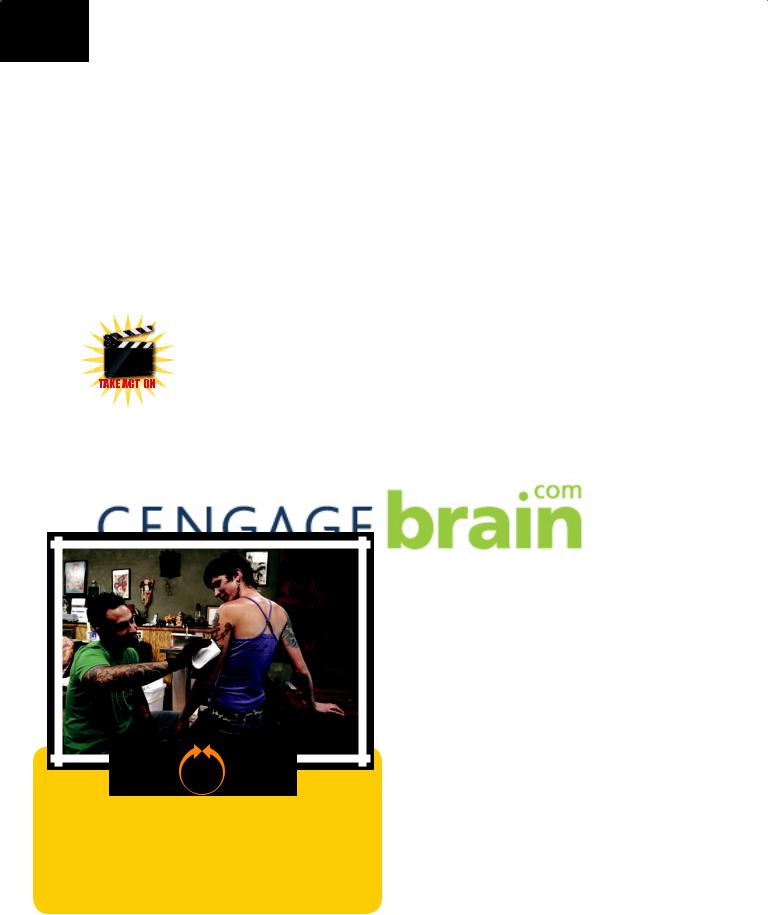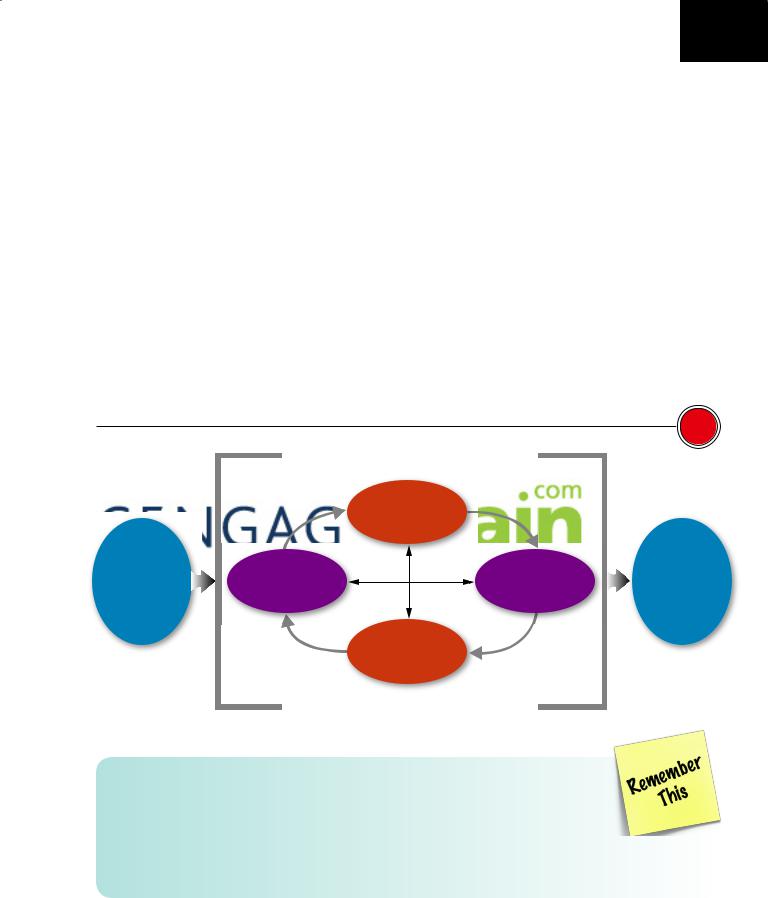
R.Daft Understanding Management
.pdf
Licensed to: CengageBrain User

Licensed to: CengageBrain User
This is an electronic version of the print textbook. Due to electronic rights restrictions, some third party content may be suppressed. Editorial review has deemed that any suppressed
content does not materially affect the overall learning experience. The publisher reserves the right to remove content from this title at any time if subsequent rights restrictions require it. For valuable information on pricing, previous editions, changes to current editions, and alternate formats, please visit www.cengage.com/highered to search by ISBN#, author, title, or keyword for materials in your areas of interest.
Copyright 2012 Cengage Learning. All Rights Reserved. May not be copied, scanned, or duplicated, in whole or in part. Due to electronic rights, some third party content may be suppressed from the eBook and/or eChapter(s). Editorial review has deemed that any suppressed content does not materially affect the overall learning experience. Cengage Learning reserves the right to remove additional content at any time if subsequent rights restrictions require it.

Licensed to: CengageBrain User
Understanding Management,
Eighth Edition
Richard L. Daft and Dorothy Marcic
Vice President of Editorial, Business: Jack W. Calhoun
Publisher: Erin Joyner Executive Editor: Scott Person
Developmental Editor: Erin Guendelsberger Senior Editorial Assistant: Ruth Belanger
Senior Marketing Communications Manager: Jim Overly
Marketing Manager: Jonathan Monahan Marketing Coordinator: Julia Tucker
Director, Education Production: Barbara Fuller Jacobsen
Content Project Manager: Emily Nesheim Media Editor: Rob Ellington
eBook Production Project Manager: Lynn Vagg
Manufacturing Planner: Ron Montgomery
Production Service: MPS Limited, a Macmillan Company
Senior Art Director: Tippy McIntosh
Cover and Internal Designer: Red Hangar Design, Ltd
Cover Image: ©ra2 studio, Shutterstock
Remember This icon: ©Francesco81, Shutterstock
Take Action icon: ©dencg, Shutterstock
Rights Acquisition Director: Audrey Pettengill
Rights Acquisition Specialist: Amber Hosea
© 2013, 2011 South-Western, Cengage Learning
ALL RIGHTS RESERVED. No part of this work covered by the copyright herein may be reproduced, transmitted, stored, or used in any form or by any means graphic, electronic, or mechanical, including but not limited to photocopying, recording, scanning, digitizing, taping, web
distribution, information networks, or information storage and retrieval systems, except as permitted under Section 107 or 108 of the 1976 United States Copyright Act, without the prior written permission of the publisher.
For product information and technology assistance, contact us at
Cengage Learning Customer & Sales Support, 1-800-354-9706
For permission to use material from this text or product, submit all requests online at www.cengage.com/permissions
Further permissions questions can be emailed to permissionrequest@cengage.com
ExamView® is a registered trademark of eInstruction Corp. Windows is a registered trademark of the Microsoft Corporation used herein under license. Macintosh and Power Macintosh are registered trademarks of Apple Computer, Inc. used herein under license.
© 2013 Cengage Learning. All Rights Reserved.
Cengage Learning WebTutor™ is a trademark of Cengage Learning.
Library of Congress Control Number: 2011940534
ISBN-13: 978-1-111-58024-7
ISBN-10: 1-111-58024-3
South-Western
5191 Natorp Boulevard
Mason, OH 45040
USA
Cengage Learning products are represented in Canada by Nelson Education, Ltd.
For your course and learning solutions, visit www.cengage.com
Purchase any of our products at your local college store or at our preferred online store www.cengagebrain.com
Printed in Canada
1 2 3 4 5 6 7 15 14 13 12 11
Copyright 2012 Cengage Learning. All Rights Reserved. May not be copied, scanned, or duplicated, in whole or in part. Due to electronic rights, some third party content may be suppressed from the eBook and/or eChapter(s). Editorial review has deemed that any suppressed content does not materially affect the overall learning experience. Cengage Learning reserves the right to remove additional content at any time if subsequent rights restrictions require it.

Licensed to: CengageBrain User |
1 |
Introduction |
Top Right: Aleksandar Bracinac/www.shutterstock.com Center: Haywiremedia/Shutterstock.com Bottom Right: Perov Stanislav/Shutterstock.com
How do you define turbulence? Flying into gusty winds at 30,000 feet? A recent breakup? This month’s cell phone bill?
For Sony Corp., turbulence is the recent data heist of more than 100 million PlayStation Network (PSN) user accounts, including stolen passwords, purchase histories, and possibly even credit card data.
The shocking news broke on April 26, 2011, when Sony’s senior director of corporate communications issued a blog post saying that the online video game network suffered a massive security break-in. The attack occurred one week earlier, as cybercriminals successfully breached Sony’s computer system, snatching private profiles and sensitive transaction information.
To prevent additional damage, Sony shut down its PlayStation and PC-based networks for nearly a month—a move that risked sending customers to Microsoft Xbox and Nintendo Wii. The crisis also prompted statements from Kazuo Hirai, Sony’s PlayStation chief, who, with other top-level managers, offered a traditional heads-bowed Japanese apology. “We deeply apologize for the inconvenience we have caused,” Hirai was quoted as saying.
Given the danger that lurks in the murky underworld of cybercrime, where hackers can breach even the firewalls of security fortresses like the Pentagon and Sony, today’s multimedia managers must possess the ability to stay calm, be visible, and tell the truth—especially when facing worst-case scenarios.
Copyright 2012 Cengage Learning. All Rights Reserved. May not be copied, scanned, or duplicated, in whole or in part. Due to electronic rights, some third party content may be suppressed from the eBook and/or eChapter(s). Editorial review has deemed that any suppressed content does not materially affect the overall learning experience. Cengage Learning reserves the right to remove additional content at any time if subsequent rights restrictions require it.

Licensed to: CengageBrain User
Chapter
1
Chapter Outline
Are You Ready to Be a Manager?
Why Innovative Management Matters
The Definition of Management
Organizational Performance
Management Skills
When Skills Fail
What Is It Like to Be a Manager?
Making the Leap: Becoming a New Manager
Manager Activities Manager Roles
Managing in Small Businesses and
Nonprofit Organizations
Innovative Management for the New |
|
Bureaucratic Organizations |
|
||
Workplace |
|
Administrative Principles |
Turbulent Forces |
|
Humanistic Perspective |
New Workplace Characteristics |
|
|
|
Early Advocates |
|
New Management Competencies |
|
|
|
Human Relations Movement |
|
|
|
|
Innovative Management Thinking for a |
|
Human Resources Perspective |
Changing World |
|
Behavioral Sciences Approach |
Contemporary Management Tools |
|
Quantitative Perspective |
Managing the Technology-Driven |
|
|
|
|
|
Workplace |
|
Recent Historical Trends |
Evolution of Management Thinking |
|
Systems Thinking |
|
Contingency View |
|
|
|
|
Management and Organization |
|
Total Quality Management |
Classical Perspective |
|
|
Scientific Management |
|
|
4
Copyright 2012 Cengage Learning. All Rights Reserved. May not be copied, scanned, or duplicated, in whole or in part. Due to electronic rights, some third party content may be suppressed from the eBook and/or eChapter(s). Editorial review has deemed that any suppressed content does not materially affect the overall learning experience. Cengage Learning reserves the right to remove additional content at any time if subsequent rights restrictions require it.
Top Left: © Robnroll, Shutterstock Top Right: © James Steidl, Shutterstock

Licensed to: CengageBrain User
Innovative Management for a Changing World
Learning Outcomes
After studying this chapter, you should be able to:
1 Explain the difference between efficiency and effectiveness, and discuss their importance for organizational performance.
2 Define ten roles that managers perform in organizations.
3 Appreciate the manager’s role in small businesses and nonprofit organizations.
4 Understand the personal challenges involved in becoming a new manager.
5 Discuss turbulent forces that require a new workplace and the innovative management competencies needed to deal with today’s environment.
6 Know the difference between the new-style and the old-style manager.
7 Understand how historical forces influence the practice of management.
8 Identify and explain major developments in the history of management thought.
9 Describe the major components of the classical and humanistic management perspectives.
10 Explain the major concepts of the contingency view and total quality management.
Shutterstock
Steidl,
©
Mostly True |
Mostly False |
(See page 17, Life on Speed Dial.)
4I like to be systematic when solving problems.
Mostly True |
Mostly False |
(See page 29, Scientific Management.)
5I have a good understanding of other people’s needs.
Mostly True |
Mostly False |
(See page 34, Human Relations Movement.)
5
© Cengage Learning 2013
Copyright 2012 Cengage Learning. All Rights Reserved. May not be copied, scanned, or duplicated, in whole or in part. Due to electronic rights, some third party content may be suppressed from the eBook and/or eChapter(s). Editorial review has deemed that any suppressed content does not materially affect the overall learning experience. Cengage Learning reserves the right to remove additional content at any time if subsequent rights restrictions require it.

Licensed to: CengageBrain User
6 |
|
Chapter 1 Innovative Management for a Changing World |
|
|
A person’s first job can be one of the most exciting times of life, but few people get the |
|
|
experience and challenge of being a manager at the age of 16. Teresa Taylor, now chief |
|
|
operating officer at Qwest, feels that she got just that. Taylor considered herself lucky to |
|
|
be working as hostess at a local restaurant, but she was a bit stunned by the level of respon- |
|
|
sibility she had. “I was in charge of scheduling, and I was in charge of deciding who gets |
|
|
to go early, who gets to come in late, who gets to go on break, who doesn’t, what stations |
|
|
should they be at,” she says. It seemed like a lot of power for someone just entering the |
|
|
workforce, but Taylor soon realized she had to listen to the servers and try to meet their |
|
|
needs in order to keep things running smoothly. It was a valuable lesson she applied many |
|
|
times in future years, especially when she stepped into an official management role. “I |
|
|
had to take a step back and say, ‘Well, I can’t muscle my way through this. I can’t do it all |
|
|
myself.’ ” Like most managers, Taylor found that the more her responsibilities grew, the |
|
|
more she had to listen to and rely on others to accomplish goals.1 |
|
|
Many new managers expect to have power, be in control, and be personally responsible |
|
|
for departmental outcomes. A big surprise for many people when they first become a man- |
|
|
ager is that they are much less in control of things than they expected. Managers depend |
|
|
on subordinates more than the reverse, and they are evaluated on the work of other people |
|
|
rather than on their own work. The nature of management is to motivate and coordinate |
|
|
others to cope with diverse and far-reaching challenges. Managers set up the systems and |
|
|
conditions that help other people perform well. |
|
|
|
|
|
In the past, many managers did exercise tight control over employees. But the field of |
What makes a good manager? |
management is undergoing a revolution that asks managers to do more with less, wholly |
|
Go to the Group Learning, |
engage employees, see change rather than stability as natural, and inspire vision and |
|
on page 44, that pertains to |
cultural values that allow people to create a truly collaborative and productive workplace. |
|
qualities and characteristics |
This textbook introduces and explains the process of management and the changing ways |
|
|
||
of effective versus ineffective |
of thinking about the world that are critical for managers. By reviewing the actions of |
|
managers. |
||
|
|
some successful and not-so-successful managers, you will learn the fundamentals of man- |
|
|
agement. By the end of this chapter, you will already recognize some of the skills manag- |
|
|
ers use to keep organizations on track, and you will |
|
|
begin to understand how managers can achieve as- |
|
|
tonishing results through people. By the end of this |
|
|
book, you will understand fundamental manage- |
|
|
ment skills for planning, organizing, leading, and |
|
|
controlling a department or an entire organization. |
Sladky |
|
Why Innovative |
|
Management Matters |
|
© AP Photo/Lynne |
|
|
|
|
|
|
The day after Haiti was hit by a massive earthquake |
|
|
|
in January 2010, Facebook users around the globe |
ConceptConnection |
were updating their statuses with the word Haiti |
|
|
|
at a rate of 1,500 times a minute. It was concrete |
A business may develop from a |
good management and vision |
evidence of the rapidly growing reach of Facebook, |
can take it to the next level. Tattoo artists Ami James and Chris Núñez (pictured) |
which started as a social networking site for college |
|
started the business Miami Ink, which was the namesake of the TLC/Discovery reality |
students. |
|
|
||
television program that ran from 2005 until 2008. The partners pitched the concept |
Facebook’s success can be attributed to its |
|
for the show with a friend and turned their business into the most well-known tattoo |
||
design studio in the United States. Because TLC/Discovery owns the rights to the |
managers’ effectiveness at innovation. Founder |
|
name Miami Ink, James and Núñez planned for life after reality TV by creating another |
and CEO Mark Zuckerberg says he wants manag- |
|
Miami Beach tattoo studio, Love Hate Tattoo. |
|
ers who aren’t afraid to break things in order to |
Copyright 2012 Cengage Learning. All Rights Reserved. May not be copied, scanned, or duplicated, in whole or in part. Due to electronic rights, some third party content may be suppressed from the eBook and/or eChapter(s). Editorial review has deemed that any suppressed content does not materially affect the overall learning experience. Cengage Learning reserves the right to remove additional content at any time if subsequent rights restrictions require it.

Licensed to: CengageBrain User
Why Innovative Management Matters |
7 |
© Cengage Learning 2013
New Manager
Self-Test
Manager Achievement Test
Rate each item below based on your orientation toward personal achievement. Read each item and check either Mostly True or Mostly False as you feel right now.
Mostly True <<< |
>>> Mostly False |
1.I enjoy the feeling I get from mastering a new skill.
2.Working alone is typically better than working in a group.
3.I like the feeling I get from winning.
4.I like to develop my skills to a high level.
5. I rarely depend on anyone else to get things done. |
|
|
|
See It |
|
|
|
Online |
|
|
|
|
|
6. I am frequently the most valuable contributor to a team.
7. I like competitive situations.
© inginsh, Shutterstock
8. To get ahead, it is important to be viewed as a winner.
Scoring and Interpretation: Give yourself 1 point for each Mostly True answer. In this case, a low score is better. A high score means a focus on personal achievement separate from others, which is ideal for a specialist or individual contributor. However, a manager is a generalist who gets things done through others. A desire to be a winner may cause you to compete with your people rather than develop their skills. As a manager, you will not succeed as a lone achiever who does not facilitate and coordinate others. If you checked three or fewer statements as Mostly True, your basic orientation is good. If you scored 6 or higher, your focus is on being an individual winner. You will want to shift your perspective to become an excellent manager.
make them better. Facebook’s management team encourages a culture of fearlessness, helping the company win the top spot on Fast Company’s 2010 list of the world’s 50 most innovative companies. Even during grim economic times, Facebook was increasing its engineering team, investing in new ideas, and pushing people to take risks for the future.2 Why does innovative management matter? Innovations in products, services, management systems, production processes, corporate values, and other aspects of the organization are what keep companies growing, changing, and thriving. Without innovation, no company can survive over the long run. In today’s world, industries, technologies, economies, governments, and societies are in constant flux, and managers are responsible for helping their organizations navigate through the unpredictable with flexibility and innovation. The meltdown of the housing and finance industries in the United States and the resulting global financial crisis, volatile oil prices and a devastating oil spill on the Gulf Coast, sweeping government changes, natural disasters such as major
Copyright 2012 Cengage Learning. All Rights Reserved. May not be copied, scanned, or duplicated, in whole or in part. Due to electronic rights, some third party content may be suppressed from the eBook and/or eChapter(s). Editorial review has deemed that any suppressed content does not materially affect the overall learning experience. Cengage Learning reserves the right to remove additional content at any time if subsequent rights restrictions require it.

Licensed to: CengageBrain User
8 |
Chapter 1 Innovative Management for a Changing World |
The
Grateful
Dead
earthquakes in Haiti and Chile, continuing threats of terrorism, massive problems for automakers from General Motors to Toyota, global health scares such as the H1N1 flu virus, and other recent events have confirmed for managers the folly of managing for stability. The growing clout and expertise of companies in developing countries, particularly China and India, also have many Western managers worried. In such a turbulent and hypercompetitive global environment, managers must help their companies innovate more—and more quickly—than ever.
People can learn to manage innovatively. Interestingly, some hard-nosed business executives have turned to a study of the Grateful Dead rock band for a lesson or two.
Who said that, “[in an information economy] the best way to raise demand for your product is to give it away”? Perhaps Jeff Bezos, founder of Amazon.com? Maybe Sergey Brin or Larry Page, cofounders of Google?
Actually, those words were written by Grateful Dead lyricist John Perry Barlow in a 1994 issue of Wired magazine, long before most people were even thinking about “Internet business models.” The Dead were famous for allowing fans to tape their shows, giving up a major source of revenue in potential record sales but dramatically widening their fan base in the process—and those fans spent plenty of money on concert tickets, merchandise, and so forth, as well as records.
Far from being lackadaisical about their jobs, Dead members always treated the band as a business, incorporating early on and establishing a board of directors that included people from all levels of the organization. They pioneered numerous ideas and practices that were later embraced by corporations. One example was their decision to focus intensely on their most loyal fan base and find ways to create and deliver superior customer value. Even more interesting is how, in a pre-Facebook world, the band found ways to foster a “community of interest” that defied distance. Decades before the Internet and social networking sites, intense bonds of friendship and loyalty often developed among Deadheads living thousands of miles apart.
Barry Barnes, a business professor who lectures to business leaders about the Grateful Dead, says the band’s ability to constantly think and behave innovatively is a lesson for today’s managers. The band thrived for decades, through bad times as well as good. “If you’re going to survive this economic downturn,” Barnes says, “you better be able to turn on a dime. The Dead were exemplars.”3
Innovation has become the new imperative, despite the need for companies to control costs in today’s economy. In a January 2009 survey of corporate executives in Asia, North America, Europe, and Latin America, 76 percent agreed that “innovation is more important than cost reduction for long-term success.”4 Throughout this text, we will spotlight various companies that reflect managers’ ability to think and act innovatively. In addition,
Chapter 8 discusses innovation and change in detail. First, let’s begin our exploration of the world of management by learning some basics about what it means to be a manager.
The Definition of Management
Every day, managers solve difficult problems, turn organizations around, and achieve astonishing performances. To be successful, every organization needs good managers.
What do managers actually do? The late famed management theorist Peter Drucker, often credited with creating the modern study of management, summed up the job of the manager by specifying five tasks.5 In essence, managers set goals, organize activities, motivate and communicate, measure performance, and develop people. These five manager activities apply not only to top executives such as Mark Zuckerberg at Facebook, Steve Odland at Office Depot, or Ursula Burns at Xerox, but also to the manager of a restaurant
Copyright 2012 Cengage Learning. All Rights Reserved. May not be copied, scanned, or duplicated, in whole or in part. Due to electronic rights, some third party content may be suppressed from the eBook and/or eChapter(s). Editorial review has deemed that any suppressed content does not materially affect the overall learning experience. Cengage Learning reserves the right to remove additional content at any time if subsequent rights restrictions require it.

Licensed to: CengageBrain User
The Definition of Management |
9 |
in your hometown, the leader of an airport security team, a supervisor at a Web hosting service, or the director of sales and marketing for a local business.
Manager’s activities fall into four core management functions: planning (setting goals and deciding activities), organizing (organizing activities and people), leading (motivating, communicating with, and developing people), and controlling (establishing targets and measuring performance). Depending on their job situation, managers perform numerous and varied tasks, but they all can be categorized under these four primary functions. Thus, our definition of management is as follows:
Management is the attainment of organizational goals in an effective and efficient manner through planning, organizing, leading, and controlling organizational resources. This definition holds two important ideas: (1) the four functions of planning, organizing, leading, and controlling, and (2) the attainment of organizational goals in an effective and efficient manner. Let’s first take a look at the four primary management functions. Later in the chapter, we’ll discuss organizational effectiveness and efficiency, as well as the multitude of skills managers use to successfully perform their jobs.
Exhibit 1.1 illustrates the process of how managers use resources to attain organizational goals through the functions of planning, organizing, leading, and controlling. Chapters of this book are devoted to the multiple activities and skills associated with each function, as well as to the environment, global competitiveness, and ethics that influence how managers perform these functions.
EXHIBIT
The Process of Management
1.1
|
|
Management Functions |
|
|
|
Planning |
|
|
|
Select goals and |
|
|
|
ways to attain them |
|
Resources |
Controlling |
Organizing |
Performance |
■ Human |
■ Attain goals |
||
■ Financial |
Monitor activities |
Assign |
■ Products |
■ Raw materials |
and make |
responsibility for task |
■ Services |
■ Technological |
corrections |
accomplishment |
■ Efficiency |
■ Information |
|
|
■ Effectiveness |
|
|
Leading |
|
|
|
Use influence to |
|
|
|
motivate employees |
|
© Cengage Learning 2013
•Managers get things done by coordinating and motivating other people.
•Management often is a different experience from what people expect.
•Innovative management is critical in today’s turbulent world.
•Facebook’s success can be attributed to the effectiveness of its innovative managers.
•Management is defined as the attainment of organizational goals in an effective and efficient manner through planning, organizing, leading, and controlling organizational resources.
Copyright 2012 Cengage Learning. All Rights Reserved. May not be copied, scanned, or duplicated, in whole or in part. Due to electronic rights, some third party content may be suppressed from the eBook and/or eChapter(s). Editorial review has deemed that any suppressed content does not materially affect the overall learning experience. Cengage Learning reserves the right to remove additional content at any time if subsequent rights restrictions require it.
